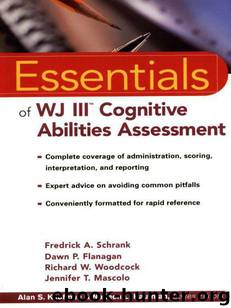Essentials of WJ III Cognitive Abilities Assessment by Fredrick A. Schrank Dawn P. Flanagan Richard W. Woodcock Jennifer T. Mascolo

Author:Fredrick A. Schrank, Dawn P. Flanagan, Richard W. Woodcock, Jennifer T. Mascolo [Schrank]
Language: eng
Format: epub
Tags: Assessment; Testing & Measurement, Psychology, Educational Psychology, Cognitive Psychology, Medical, Mental Health, General, Woodcock-Johnson Tests of Cognitive Ability, Testing & Measurement, Psychiatry, Education, Personality
ISBN: 9780471344667
Publisher: Wiley
Published: 2002-04-15T07:00:00+00:00
WJ III Intra-Individual Discrepancies
Intra-Individual Discrepancies
Source: Adapted from WJ III Technical Manual, p. 5, Riverside Publishing 2001.
Table 4.4 Compuscore Version 1.1b Score Report for Kayla W. (Intra-Individual Discrepancies)
Step 3
Determine whether significant differences exist between or among the tests that comprise a
cluster. The WJ III emphasizes the principle of cluster interpretation. However, when performance on two tests that comprise a cluster is significantly different, the cluster score may not adequately capture important interpretive information because each test in the cluster is intended to measure a qualitatively different narrow ability. Consequently, when tests that comprise a cluster differ significantly, you should interpret the individual’s performance at the narrow ability (Stratum I) level.
To determine if there are significant differences between two tests that comprise a cluster, compare the confidence bands for the tests on the Standard Score/Percentile Rank Profile. The Standard Score/Percentile Rank Profile can be printed from the WJ III CPP. Figure 4.5 is a display from the Standard Score/Percentile Rank Profile. This profile portrays the 68% confidence band for an individual’s standard scores and percentile ranks. The band provides a range of scores that would contain the point at which an individual’s true score would fall two out of three times. The confidence band is centered on the individual’s obtained score.
Rapid Reference 4.5 provides three rules for interpreting the differences between two tests in a cluster. When this procedure is applied to a cluster that is comprised of more than two tests (such as Broad Attention, Executive Processes, Cognitive Fluency, Thinking Ability—Std, Thinking Ability—Ext, Cognitive Efficiency—Ext, Brief Intellectual Ability, GIA-Std, GIA-Ext), multiple comparisons are being made, and it is possible that differences could be found as a result of chance. Consequently, the rules in the procedure are primarily recommended for two-test comparisons. (You may want to determine if two unrelated tests or clusters are significantly different—for example, when all clusters have not been administered for calculation of intracognitive discrepancies.)
Download
This site does not store any files on its server. We only index and link to content provided by other sites. Please contact the content providers to delete copyright contents if any and email us, we'll remove relevant links or contents immediately.
The Art of Coaching Workbook by Elena Aguilar(50989)
Trainspotting by Irvine Welsh(21519)
Twilight of the Idols With the Antichrist and Ecce Homo by Friedrich Nietzsche(18503)
Fangirl by Rainbow Rowell(9096)
Periodization Training for Sports by Tudor Bompa(8170)
Change Your Questions, Change Your Life by Marilee Adams(7635)
This Is How You Lose Her by Junot Diaz(6794)
Asking the Right Questions: A Guide to Critical Thinking by M. Neil Browne & Stuart M. Keeley(5636)
Grit by Angela Duckworth(5523)
Red Sparrow by Jason Matthews(5390)
Paper Towns by Green John(5090)
Room 212 by Kate Stewart(5037)
Ken Follett - World without end by Ken Follett(4645)
Housekeeping by Marilynne Robinson(4347)
The Sports Rules Book by Human Kinetics(4294)
Double Down (Diary of a Wimpy Kid Book 11) by Jeff Kinney(4207)
Papillon (English) by Henri Charrière(4195)
The Motorcycle Diaries by Ernesto Che Guevara(4012)
Exercise Technique Manual for Resistance Training by National Strength & Conditioning Association(3956)
